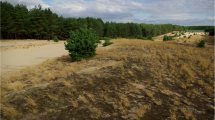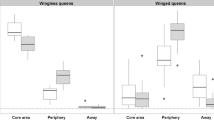Summary
12 samples ofFormicoxenus hirticornis (Emery) were collected from 4Formica obscuripes nests in the Yellowstone Park, Wyoming, in August, 1977. The dealate females and intermorphs, and some workers were dissected. All 16 females and 13 of the 16 intermorphs were inseminated, but only 10 females and 4 intermorphs were egg-laying. It seems that each colony normally contains only one fully fertile specimen, and a few additional, inseminated but sterile females or intermorphs. These results are very similar to our observations on the European guest-antFormicoxenus nitidulus (Nyl.). We conclude thatF. hirticornis (and maybe the closely relatedF. diversipilosus, too) is functionally monogynous likeF. nitidulus andLeptothorax gredleri Mayr, which means that supernumerary inseminated females and intermorphs are accepted in queenright colonies, but they are kept sterile by a mechanism which is not yet known.
Leptothorax hirticonis Emery andL. diversipilosus M.R. Smith in my opinion belong to the genusFormicoxenus, since they have, together withF. nitidulus, a number of unique, common characters: The males of all three species are wingless and workerlike, they all live as guest ants in the mound nests ofFormica species, and they have a peculiar female polymorphism with both dealate and intermorphic queens besides normal workers.
Zusammenfassung
12 Proben vonFormicoxenus hirticornis (Emery) wurden im August 1977 im Yellowstone Park, Wyoming, aus 4 Nestern vonFormica obscuripes entnommen. Die entflügelten Weibchen und Intermorphen sowie einige Arbeiterinnen wurden seziert. Alle 16 Weibchen und 13 der Intermorphen waren begattet, doch legten nur 10 Weibchen und 4 Intermorphe Eier. des Volk scheint normalerweise nur ein voll fertiles und daneben einige zusätzliche, begattete, aber sterile Weibchen oder Intermorphe zu enthalten. Diese Ergebnisse sind unseren Beobachtungen an der europäischen GastameiseFormicoxenus nitidulus (Nyl.) sehr ähnlich. Wir schließen daraus, daßF. hirticornis (und vielleicht auch der nahe verwandteF. diversipilosus) wieF. nitidulus undLeptothorax gredleri Mayr funktionell monogyn ist, das heißt, daß überzählige begattete Weibchen und Intermorphe in weiselrichtigen Sozietäten zwar akzeptiert, aber durch einen bisher unbekannten Mechanismus steril gehalten werden.
Leptothorax hirticornis Emery undL. diversipilosus M.R. Smith gehören meines Erachtens in die GattungFormicoxenus, da sie eine Anzahl einzigartiger Merkmale mitF. nitidulus gemeinsam haben: Die Männchen aller drei Arten sind flügellos und arbeiterinähnlich, alle drei leben als Gastameisen in Hügelnestern vonFormica-Arten, und sie haben einen merkwürdigen Polymorphismus mit entflügelten und intermorphen königinnen neben normalen Arbeiterinnen.
Similar content being viewed by others
References
Adlerz G., 1884. — Myrmecologiska studier. I.Formicoxenus nitidulus Nyl.Kongl. Vetensk. Akad. Förhandl., 8, 43–64.
Alpert G.D., Akre R.D., 1973. — Distribution, Abundance, and Behavior of the Inquiline AntLeptothorax diversipilosus.Ann. Entomol. Soc. Am., 66, 753–760.
Buschinger A., 1968. — Mono- und Polygynie bei Arten der GattungLeptothorax Mayr (Hymenoptera Formicidae).Ins. Soc., 15, 217–226.
Buschinger A., 1976. — Eine Methode zur Zucht der GastameiseFormicoxenus nitidulus (Nyl.) mitLeptothorax acervorum (Fabr.) als ≪Wirtsameise≫ (Hym. Form.).Ins. Soc., 23, 205–214.
Buschinger A., Winter U., 1976. — Funktionelle Monogynie bei der GastameiseFormicoxenus nitidulus (Nyl.) (Hym. Form.).Ins. Soc., 23, 549–558.
Donisthorpe H.St.J.K., 1927. — British Ants.Routledge, edit., London, XV + 379 p.
Emery C., 1895. — Beiträge zur Kenntnis der nordamerikanischen Ameisenfauna.Zool. Jb. Syst., 8, 257–360.
Gervet J., 1956. — L'action des températures différentielles sur la monogynie fonctionnelle chez lesPolistes (Hym. Vespides).Ins. Soc., 3, 159–176.
Pardi L., 1940. — Ricerche suiPolistini. 1. Poliginia vera et apparente inPolistes gallicus L.Atti Soc. Toscana Sci. Nat., 49, 3–9.
Smith M.R., 1939 — Notes onLeptothorax (Mychothorax) hirticornis Emery, and des-cription of a related new species (Formicidae).Proc. Ent. Soc. Wash., 41, 176–180.
Smith M.R., 1956. — A further contribution to the taxonomy and biology of the Inquiline Ant,Leptothorax diversipilosus Smith.Proc. Entomol. Soc. Wash., 58, 271–275.
Snelling R.R., 1965. — Studies on California ants. 1.Leptothorax hirticornis Emery, a new host and descriptions of the female and ergatoid male (Hymenoptera: Formicidae).Bull. S. Calif. Acad. Sci., 64, 16–21.
Stager R., 1925. — Das Leben der Gastameise (Formicoxenus nitidulus Nyl.) in neuer Beleuchtung.Z. Morph. Okol. Tiere, 3, 452–476.
Stumper, R., 1918. —Formicoxenus nitidulus Nyl., I. Beitrag.Biol. Centralbl., 38, 160–179.
Stumper R., 1949. — Etudes myrmécologiques. IX. Nouvelles observations sur l'éthologie deFormicoxenus nitidulus Nyl.Bull. Soc. Nat. Luxembourg, N. Ser.43, 242–248.
Wasmann E.S.J., 1915. — Das Gesellschaftsleben der Ameisen. 2. Aufl., Aschendorffsche Verlagsbuchhandl., Münster, XVIII + 413 p.
Wheeler W.M., 1910. — Ants.Columbia Press, Publ., New York and London, XXV + 663 p.
Author information
Authors and Affiliations
Rights and permissions
About this article
Cite this article
Buschinger, A. Functional monogyny in the American guest antFormicoxenus hirticornis (Emery) (=Leptothorax hirticornis), (Hym., Form.). Ins. Soc 26, 61–68 (1979). https://doi.org/10.1007/BF02283913
Received:
Accepted:
Issue Date:
DOI: https://doi.org/10.1007/BF02283913




